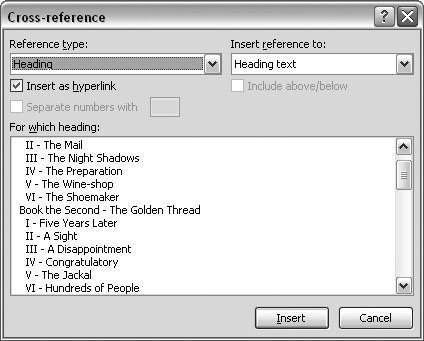9.6. Cross-Referencing Your Document Schoolbooks, business reports , and a variety of other documents use cross-references to refer to photos, figures, charts , tables, and other parts of the document. When readers view your document on a computer, they can Ctrl-click the reference to jump to that spot. For example, clicking the words "Chart A" takes the reader right to the chart in your document. You can turn this chore over to Word with confidence that it will keep track of the reference and the page number for you, even as you add or move material. With Word you can create cross-references to the following items: -
Numbered item . Numbered paragraphs in your text created with the Home  Paragraph Paragraph  Numbering command (Alt+H, N). Numbering command (Alt+H, N). -
Bookmark . Bookmarks in your text that refer to specific locations or ranges of pages. Bookmarks are inserted with the keyboard shortcut Alt+N, K. -
Heading . A paragraph you styled with a built-in headings such as Heading 1or Heading 2. -
Footnote . Word keeps track of your footnotes' locations and their numbers . -
Endnote . Endnotes are a little easier for a human to hunt down; still, Word keeps track of their locations and page numbers. -
Equation . For documents dealing with math, Word keeps track of all the equations created with the built-in equation editor. -
Figure . When you insert pictures and label them with a caption, Word keeps track of the "figure" number. For a step-by-step description of creating crossreferences for figures, see Section 9.6. -
Table . Tables with or without captions are tallied in Word, and you can create cross-references to them. Here are the steps for adding a cross-reference to your document: -
In your document, type the text you'd like to go before the reference . Usually, cross-references have some preceding introductory text, like As shown in or For more details, see . You have to type this part yourself; Word adds the cross-reference (the Ctrl-clickable text or page number). -
Go to Insert  Links Links  Cross-reference. When the Cross-reference dialog box opens (Figure 9-20), use the "Reference type drop-down menu to choose the object that you're referring to . Cross-reference. When the Cross-reference dialog box opens (Figure 9-20), use the "Reference type drop-down menu to choose the object that you're referring to . Whichever type you choose, in the text box below, Word shows you a list of the specific items in your document (numbered items, bookmarks, headings, and so on) that are candidates for cross-referencing. -
From the "Insert reference to" menu, choose the text that describes the reference . Here's where you select what appears in your documentthe text that your readers can read and Ctrl-click. Your choices from this menu depend on what you've chosen from the "Reference type" menu. For example, if you're referring to a heading, you can choose to insert the heading text itself (Figure 9-20), or just the page number. -
If desired, turn on the "Insert above/below" checkbox . In addition, you can insert either the word "above" or the word "below" to indicate where the item is relative to the cross-reference. For example, say you're putting the cross-reference "see Table 1," before Table 1 in your document. If you turn on this checkbox, the reference reads "see Table 1 below." If you happen to move Table 1 to before the cross-reference, Word changes it to "see Table 1 above." This way, if your readers print your document, they have a clue where to go looking for the cross-reference without the benefit of a hyperlink.
Tip: Of course, if your readers are hard-copy types, choose the page number from the "Insert reference to" menu (step 3), so they'll know exactly where to look.
-
When you're done, click Insert to close the Cross-reference dialog box . Back in your document, you see your newly minted cross-reference.  | Figure 9-20. In the Cross-reference box, use the "Reference type" drop-down menu to choose the type of item you're referring to and the "Insert reference to" menu to choose what actually appears in your text. For example, you could choose a page number, a figure number, or the text from a caption. | |
9.6.1. 9.6.1.1. Deleting cross-references You can delete a cross-reference as you'd delete any text; just select it, and then press the Delete or Backspace key. |
 Paragraph
Paragraph 